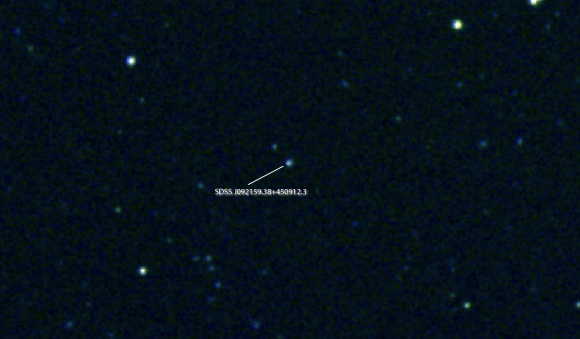In an effort to better understand how the Universe evolved as the first stars were formed, U.S. astronomers led by Dr Sanchayeeta Borthakur of Johns Hopkins University have discovered SDSS J092159.38+450912.3, a unique star-forming galaxy that emits incredibly massive amounts of UV radiation.

This image show the star-forming galaxy SDSS J092159.38+450912.3. Image credit: Centre de Données astronomiques de Strasbourg / SIMBAD.
Moments after the start of the Big Bang, the hot Universe began to expand and quickly cool.
Several hundred thousand years later, free protons and electrons in the Universe began to connect to each other and form a neutral hydrogen gas.
During a period called the Epoch of Reionization, the gas went from being almost completely neutral to a state in which it became almost completely ionized.
This event – which has occurred when the Universe was a few hundred million years old and the first radiating objects formed – is intimately linked to many fundamental questions in cosmology and structure formation and evolution.
To shed light on the complex physics of the reionization process, Dr Borthakur and her colleagues set out to find a dense star-forming galaxy that emits huge amounts of UV radiation after UV rays escape from its cloud cover of dust and neutral hydrogen.
“It’s like the ozone layer, but in reverse. The ozone layer protects us from the sun’s radiation but we want the gas cover the other way around. The star forming regions in galaxies are covered with cold gases so the radiation cannot come out. If we can find out how the radiation gets out of the galaxy, we can learn what mechanisms ionized the Universe,” explained Dr Borthakur, who is the first author of a paper published in the journal Science.
Using observations made with NASA’s Hubble Space Telescope, the scientists found the right object – SDSS J092159.38+450912.3 (J0921+4509 for short).
The galaxy is located in the constellation Ursa Major, about 2.9 billion light-years from Earth.
While regular galaxies emit only one percent UV radiation into the surrounding intergalactic medium, J0921+4509 emits up to 21 per cent of its ionizing radiation.
It belongs to a special class of galaxies where several billion solar masses of stars are produced in an extremely compact central region with a radius of 300 light-years.
_____
Sanchayeeta Borthakur et al. 2014. A local clue to the reionization of the Universe. Science, vol. 346, no. 6206, pp. 216-219; doi: 10.1126/science.1254214







